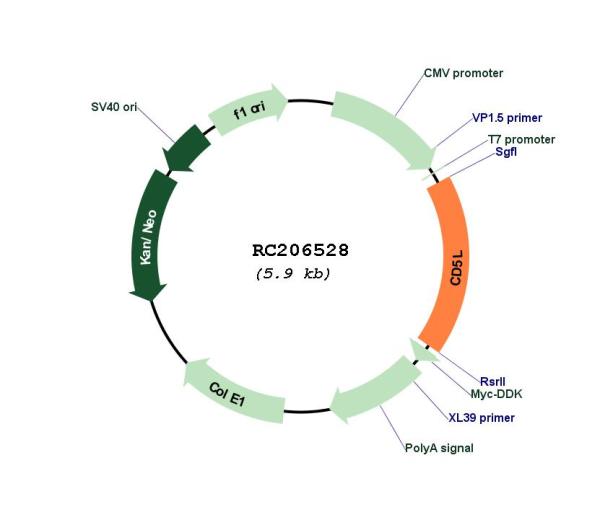AIM (CD5L) (NM_005894) Human Tagged ORF Clone
CAT#: RC206528
CD5L (Myc-DDK-tagged)-Human CD5 molecule-like (CD5L)
ORF Plasmid: tGFP
Lentiviral Particles: DDK DDK w/ Puro mGFP mGFP w/ Puro
AAV Particle: DDK
"NM_005894" in other vectors (6)
USD 198.00
Specifications
| Product Data | |
| Type | Human Tagged ORF Clone |
| Tag | Myc-DDK |
| Symbol | AIM |
| Synonyms | AIM; API6; CT-2; hAIM; PRO229; SP-ALPHA; Spalpha |
| Vector | pCMV6-Entry |
| E. coli Selection | Kanamycin (25 ug/mL) |
| Mammalian Cell Selection | Neomycin |
| Sequence Data |
>RC206528 ORF sequence
Red=Cloning site Blue=ORF Green=Tags(s) TTTTGTAATACGACTCACTATAGGGCGGCCGGGAATTCGTCGACTGGATCCGGTACCGAGGAGATCTGCC GCCGCGATCGCC ATGGCTCTGCTATTCTCCTTGATCCTTGCCATTTGCACCAGACCTGGATTCCTAGCGTCTCCATCTGGAG TGCGGCTGGTGGGGGGCCTCCACCGCTGTGAAGGGCGGGTGGAGGTGGAACAGAAAGGCCAGTGGGGCAC CGTGTGTGATGACGGCTGGGACATTAAGGACGTGGCTGTGTTGTGCCGGGAGCTGGGCTGTGGAGCTGCC AGCGGAACCCCTAGTGGTATTTTGTATGAGCCACCAGCAGAAAAAGAGCAAAAGGTCCTCATCCAATCAG TCAGTTGCACAGGAACAGAAGATACATTGGCTCAGTGTGAGCAAGAAGAAGTTTATGATTGTTCACATGA TGAAGATGCTGGGGCATCGTGTGAGAACCCAGAGAGCTCTTTCTCCCCAGTCCCAGAGGGTGTCAGGCTG GCTGACGGCCCTGGGCATTGCAAGGGACGCGTGGAAGTGAAGCACCAGAACCAGTGGTATACCGTGTGCC AGACAGGCTGGAGCCTCCGGGCCGCAAAGGTGGTGTGCCGGCAGCTGGGATGTGGGAGGGCTGTACTGAC TCAAAAACGCTGCAACAAGCATGCCTATGGCCGAAAACCCATCTGGCTGAGCCAGATGTCATGCTCAGGA CGAGAAGCAACCCTTCAGGATTGCCCTTCTGGGCCTTGGGGGAAGAACACCTGCAACCATGATGAAGACA CGTGGGTCGAATGTGAAGATCCCTTTGACTTGAGACTAGTAGGAGGAGACAACCTCTGCTCTGGGCGACT GGAGGTGCTGCACAAGGGCGTATGGGGCTCTGTCTGTGATGACAACTGGGGAGAAAAGGAGGACCAGGTG GTATGCAAGCAACTGGGCTGTGGGAAGTCCCTCTCTCCCTCCTTCAGAGACCGGAAATGCTATGGCCCTG GGGTTGGCCGCATCTGGCTGGATAATGTTCGTTGCTCAGGGGAGGAGCAGTCCCTGGAGCAGTGCCAGCA CAGATTTTGGGGGTTTCACGACTGCACCCACCAGGAAGATGTGGCTGTCATCTGCTCAGGA AGCGGACCGACGCGTACGCGGCCGCTCGAGCAGAAACTCATCTCAGAAGAGGATCTGGCAGCAAATGATATCC TGGATTACAAGGATGACGACGATAAGGTTTAA >RC206528 protein sequence
Red=Cloning site Green=Tags(s) MALLFSLILAICTRPGFLASPSGVRLVGGLHRCEGRVEVEQKGQWGTVCDDGWDIKDVAVLCRELGCGAA SGTPSGILYEPPAEKEQKVLIQSVSCTGTEDTLAQCEQEEVYDCSHDEDAGASCENPESSFSPVPEGVRL ADGPGHCKGRVEVKHQNQWYTVCQTGWSLRAAKVVCRQLGCGRAVLTQKRCNKHAYGRKPIWLSQMSCSG REATLQDCPSGPWGKNTCNHDEDTWVECEDPFDLRLVGGDNLCSGRLEVLHKGVWGSVCDDNWGEKEDQV VCKQLGCGKSLSPSFRDRKCYGPGVGRIWLDNVRCSGEEQSLEQCQHRFWGFHDCTHQEDVAVICSG SGPTRTRPLEQKLISEEDLAANDILDYKDDDDKV |
| Chromatograms |
CHROMATOGRAMS
 Sequencher program is needed, download here. |
| Restriction Sites |
SgfI-RsrII
Cloning Scheme for this gene
Plasmid Map

|
| ACCN | NM_005894 |
| ORF Size | 1041 bp |
| OTI Disclaimer | The molecular sequence of this clone aligns with the gene accession number as a point of reference only. However, individual transcript sequences of the same gene can differ through naturally occurring variations (e.g. polymorphisms), each with its own valid existence. This clone is substantially in agreement with the reference, but a complete review of all prevailing variants is recommended prior to use. More info |
| OTI Annotation | This clone was engineered to express the complete ORF with an expression tag. Expression varies depending on the nature of the gene. |
| Product Components | The ORF clone is ion-exchange column purified and shipped in a 2D barcoded Matrix tube containing 10ug of transfection-ready, dried plasmid DNA (reconstitute with 100 ul of water). |
| Reconstitution | 1. Centrifuge at 5,000xg for 5min. 2. Carefully open the tube and add 100ul of sterile water to dissolve the DNA. 3. Close the tube and incubate for 10 minutes at room temperature. 4. Briefly vortex the tube and then do a quick spin (less than 5000xg) to concentrate the liquid at the bottom. 5. Store the suspended plasmid at -20°C. The DNA is stable for at least one year from date of shipping when stored at -20°C. |
| Reference Data | |
| RefSeq | NM_005894.3 |
| RefSeq Size | 2248 bp |
| RefSeq ORF | 1044 bp |
| Locus ID | 922 |
| UniProt ID | O43866 |
| Cytogenetics | 1q23.1 |
| Domains | SR |
| Protein Families | Druggable Genome, Secreted Protein |
| MW | 38.1 kDa |
| Gene Summary | Secreted protein that acts as a key regulator of lipid synthesis: mainly expressed by macrophages in lymphoid and inflamed tissues and regulates mechanisms in inflammatory responses, such as infection or atherosclerosis. Able to inhibit lipid droplet size in adipocytes. Following incorporation into mature adipocytes via CD36-mediated endocytosis, associates with cytosolic FASN, inhibiting fatty acid synthase activity and leading to lipolysis, the degradation of triacylglycerols into glycerol and free fatty acids (FFA). CD5L-induced lipolysis occurs with progression of obesity: participates in obesity-associated inflammation following recruitment of inflammatory macrophages into adipose tissues, a cause of insulin resistance and obesity-related metabolic disease. Regulation of intracellular lipids mediated by CD5L has a direct effect on transcription regulation mediated by nuclear receptors ROR-gamma (RORC). Acts as a key regulator of metabolic switch in T-helper Th17 cells. Regulates the expression of pro-inflammatory genes in Th17 cells by altering the lipid content and limiting synthesis of cholesterol ligand of RORC, the master transcription factor of Th17-cell differentiation. CD5L is mainly present in non-pathogenic Th17 cells, where it decreases the content of polyunsaturated fatty acyls (PUFA), affecting two metabolic proteins MSMO1 and CYP51A1, which synthesize ligands of RORC, limiting RORC activity and expression of pro-inflammatory genes. Participates in obesity-associated autoimmunity via its association with IgM, interfering with the binding of IgM to Fcalpha/mu receptor and enhancing the development of long-lived plasma cells that produce high-affinity IgG autoantibodies (By similarity). Also acts as an inhibitor of apoptosis in macrophages: promotes macrophage survival from the apoptotic effects of oxidized lipids in case of atherosclerosis (PubMed:24295828). Involved in early response to microbial infection against various pathogens by acting as a pattern recognition receptor and by promoting autophagy (PubMed:16030018, PubMed:24223991, PubMed:24583716, PubMed:25713983).[UniProtKB/Swiss-Prot Function] |
Documents
| Product Manuals |
| FAQs |
| SDS |
Resources
Other Versions
| SKU | Description | Size | Price |
|---|---|---|---|
| RC206528L1 | Lenti ORF clone of Human CD5 molecule-like (CD5L), Myc-DDK-tagged |
USD 757.00 |
|
| RC206528L2 | Lenti ORF clone of Human CD5 molecule-like (CD5L), mGFP tagged |
USD 757.00 |
|
| RC206528L3 | Lenti ORF clone of Human CD5 molecule-like (CD5L), Myc-DDK-tagged |
USD 757.00 |
|
| RC206528L4 | Lenti ORF clone of Human CD5 molecule-like (CD5L), mGFP tagged |
USD 757.00 |
|
| RG206528 | CD5L (tGFP-tagged) - Human CD5 molecule-like (CD5L) |
USD 657.00 |
|
| SC116428 | CD5L (untagged)-Human CD5 molecule-like (CD5L) |
USD 457.00 |
{0} Product Review(s)
Be the first one to submit a review






























































































































































































































































 Germany
Germany
 Japan
Japan
 United Kingdom
United Kingdom
 China
China





